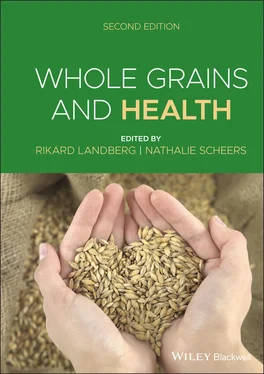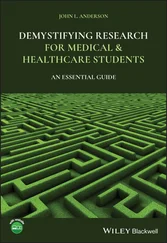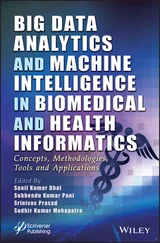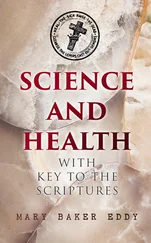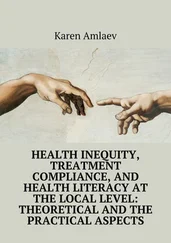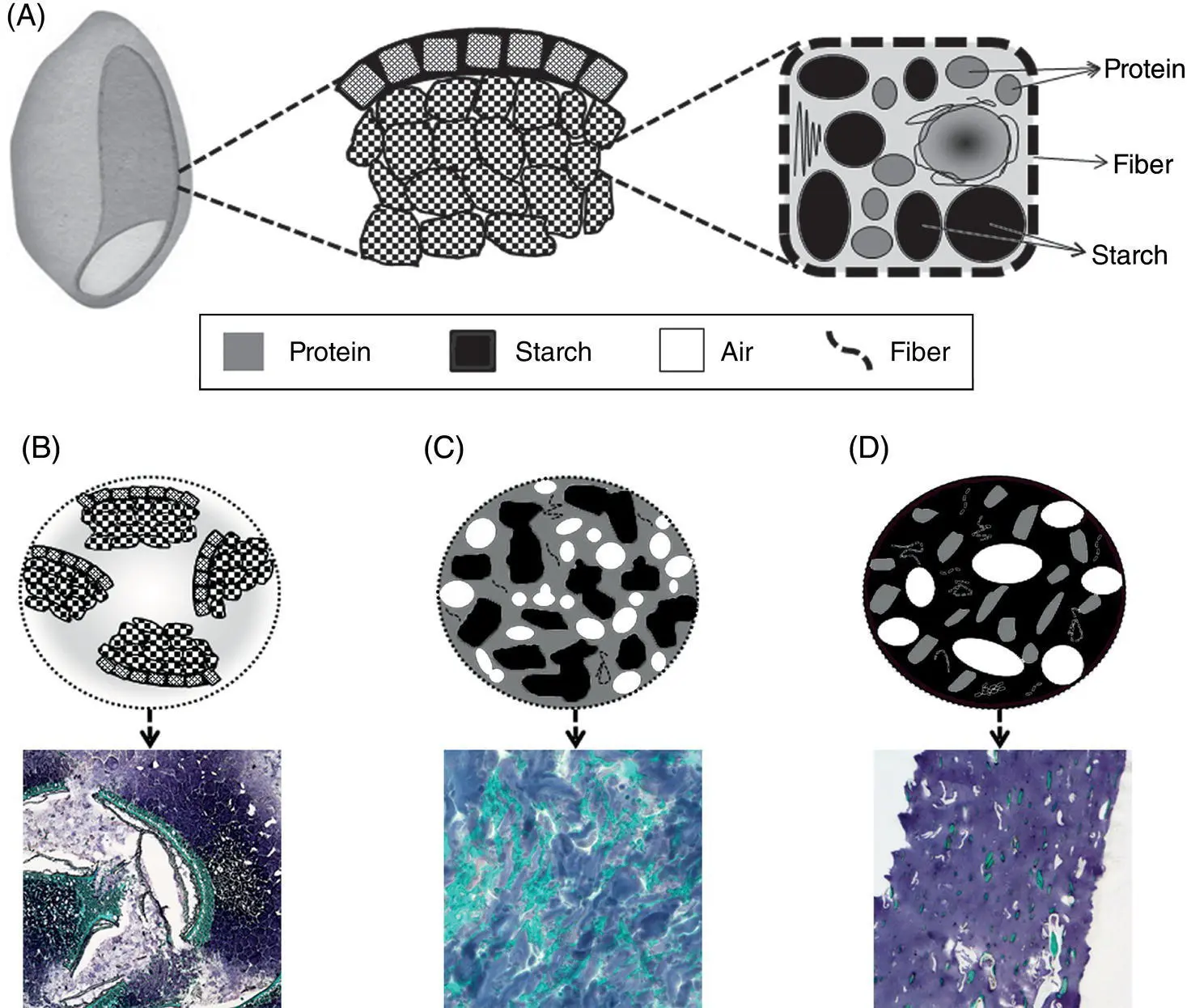
Figure 1.2 Schematic representation of a typical endosperm cell (A) and microstructure of different cereal products such as rye porridge (B), wheat bread (C) and extruded rye breakfast cereal (D). Starch and protein can be observed in blue/purple and green, respectively.
Structure is also essential for nutritional properties since it influences the bolus structure before swallowing as well as further gastrointestinal digestion. Most studies have been focused on defining or creating food structures, but knowledge on food structure breakdown during consumption is also needed. In this way, gelatinized starch is more rapidly digested than in its native crystalline form and compact products such as pasta or porridge are more slowly digested than porous ones. At the molecular level, the amylose component of starch is more slowly digested than amylopectin, and the use of high‐amylose raw materials helps lowering the glycaemic response (Alminger and Eklund‐Jonsson 2008; Poutanen et al. 2014). This could be partly due to the lower swelling capacity of high amylose starch granules compared to waxy starch granules (Lii et al. 1996). The presence of sucrose or emulsifiers has also been shown to delay the swelling of starch granules (Richardson et al. 2003). The length of the amylose chains and interactions between starch and other components in the product such as proteins, dietary fibre or lipids can also influence the digestibility of starch (Sajilata et al. 2006).
Structural characteristics of cells and tissues influence grain quality and performance in food processes. These microstructural changes can be studied using a variety of microscopy techniques such as light microscopy, confocal laser scanning microscopy (CLSM) and electron microscopy. Light microscopy provides lower magnification than, for instance electron microscopy but it allows specific staining of different chemical components. This is particularly useful in cereal products, which are complicated multicomponent multiphase materials. For instance, amylose and amylopectin can be identified under the light microscopy by staining with iodine (Langton and Hermansson 1989; Autio and Salmenkallio‐Marttila 2001). Iodine staining also allows subsequent image analyses and obtaining quantitative results (Srikaeo et al. 2006). Some staining systems can also be used in CSLM, which requires a lower degree of sample preparation compared to other microscopy techniques (Autio and Salmenkallio‐Marttila 2001). Moreover, the use of fluorescently labelled antibodies has high potential due to the combination of immunological specificity with the sensitivity of fluorescence (Vázquez‐Gutiérrez and Langton 2015). Scanning electron microscopy (SEM) permits three‐dimensional observation of a wide spectrum of food structures. Since this technique does not require sectioning, it is appropriate for visualization of porous structures and sample preparation is easier compared to light microscopy (Sanchez‐Pardo et al. 2008). SEM has been used to observe cooking‐induced changes in starch granules and protein matrix (Srikaeo et al. 2006; Sanchez et al. 2008).
1.6 Rolled cereals and porridge
The structure of cereal products such as muesli and porridge, just before their consumption, is composed of rolled whole grains or grain fragments in a continuous aqueous phase. The confinement of a great part of the starch inside the cellular structure of the grain fragments (which are semi‐intact inside the cells) is an efficient way of slowing down starch digestion, compared to other products with higher proportion of gelatinized starch such as bread (Poutanen et al. 2014). However, it has also been suggested that porridge, due to its semisolid nature, could be emptied faster from the gastric compartment. In cases where porridge is made from flour rather than flakes, this could result in faster intestinal hydrolysis of starch and release of glucose (Johansson et al. 2018).
Rolled cereal, such as oat, rye or wheat, is one of the main components of muesli. The elaboration of rolled cereal involves steaming, pressing between rollers and drying of the grains. Light microscopy images of rolled rye show that cell walls are partially disrupted after the rolling process, gluten bodies are deformed developing a more network‐like structure within the particulate fragments, and starch is partially gelatinized after the drying ( Figure 1.3). In this way, the resulting rolled grains absorb water more quickly and, in the case of those consumed as porridge, the cooking time decreases as the thickness of the rolled grains decreases. There is also a relationship between the rolled grain size and its subsidiary effects on digestion and colonic microbiota fermentation. The thickness would determine the availability and types of dietary fibre that are able to avoid digestion, and this would in turn have a consequence in the fermentation profile (Connolly et al. 2010).
Porridge is a dish made by boiling rolled or crushed cereal, usually oats, in water, milk or both, usually served hot in a bowl or dish. From the structural point of view, porridge is a compact cereal product where insoluble fragments of grain are dispersed in viscous grain extract. The boiling process favors the partial release of amylose from the starch granules and their swelling which, together with the amounts of β‐glucan solubilized from the cell walls, directly affect the viscosity and the texture of the product (Source: Yiu et al. 1987; Vázquez‐Gutiérrez et al. 2015) ( Figure 1.2B).
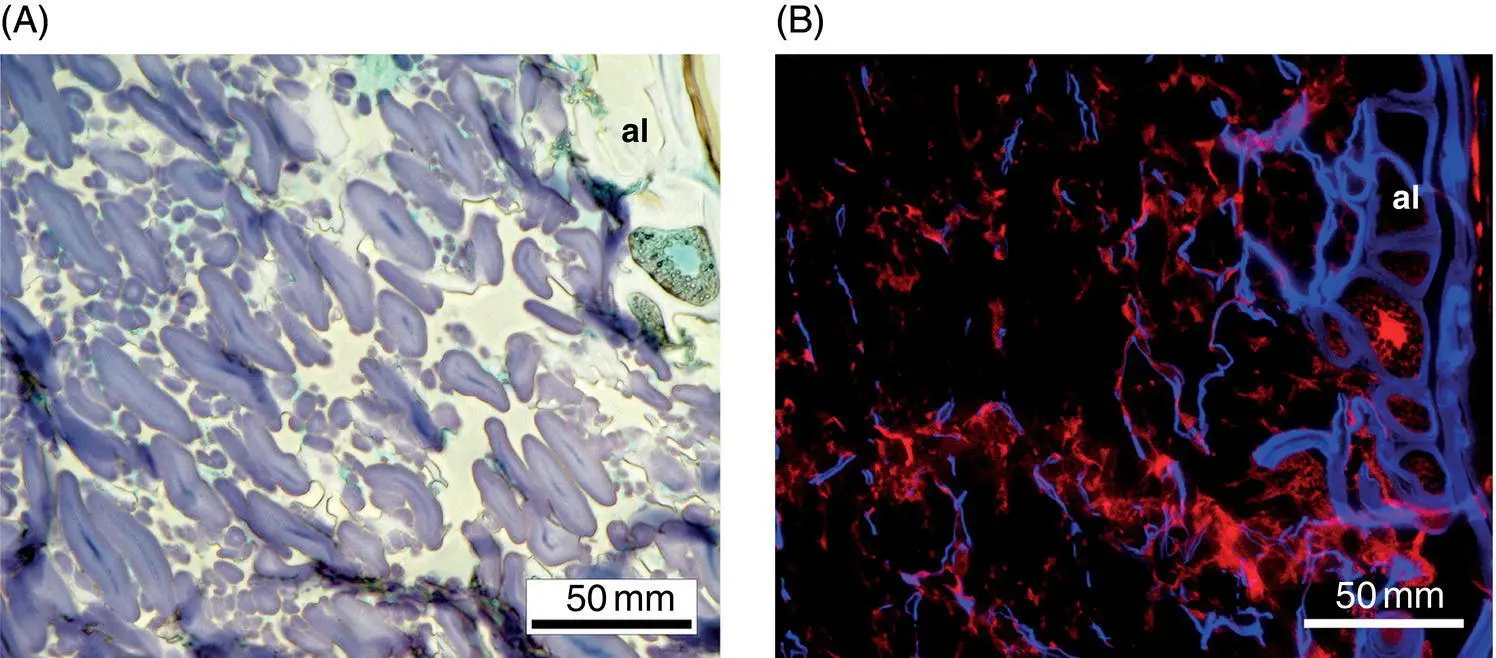
Figure 1.3 Microstructure of rolled rye grain. A: bright field micrograph with iodine and light green staining for observation of starch (purple) and protein (green), respectively; B: epifluorescence micrograph with Calcofluor and Acid Fuchsin staining for observation of cell walls (blue) and protein (red), respectively.
1.7 Protein network‐based products
The formation of gluten is essential for the structure and texture of bread, cakes and pasta.
With the addition of water to wheat flour and subsequent mixing, the storage proteins of the wheat endosperm (glutenin and gliadin) hydrate and interact to develop the gluten matrix, which provides viscoelastic properties to the dough and allows the incorporation of air (Autio and Salmenkallio‐Marttila 2003; Boitte et al. 2013). The gluten forms the continuous phase in which starch granules, lipid, added yeast cells, and cell wall fragments are dispersed ( Figure 1.2C). The aggregation of gliadins and glutenins are greatly determined by noncovalent bonds and define the structural and physical properties of the dough. The quantity and quality of gluten proteins largely determine dough mixing requirements and the rheological properties, which influences the gas retention properties and the volume and crumb structure of the resulting bread (Chavan and Chavan 2011). Apart from gluten, the other components affecting the distribution of water in the dough, such as starch and cell walls, have a direct influence on the final texture of bread, too (Flander 2012).
During yeast fermentation, carbon dioxide is generated and the dough expands. At the beginning of the fermentation process, the gas cells are embedded in the starch‐protein matrix. At a later stage of expansion, the matrix fails to enclose the gas cells and areas containing only liquid film are formed between adjacent gas cells. The end of dough expansion is marked by the rupture of the film, and not that of the starch–protein matrix (Gan et al. 1995). The major structural changes at the microscopic level during baking are starch gelatinization, denaturation of protein, melting of fat crystals and their incorporation into the surface of air cells and, sometimes, fragmentation of the cell walls (Autio and Salmenkallio‐Marttila 2001). Therefore, the final crumb structure is dependent not only on the shape, number and size of gas bubbles, but also on the structural properties of gluten‐starch matrix and probably on liquid film composed of surface‐active material (Autio and Salmenkallio‐Marttila 2003). The addition of shortenings stabilizes the gas cells. The fat crystals from the shortenings migrate towards the gas‐liquid interface and they melt during baking, allowing the bubbles to grow without rupture (Brooker 1996). Light microscopy is the most commonly used technique to determine bread structure (Jakubczyk et al. 2008). Scanning and transmission electron microscopy have also been used to study the effect of baking on starch granule structure (Bechtel 1985).
Читать дальше
